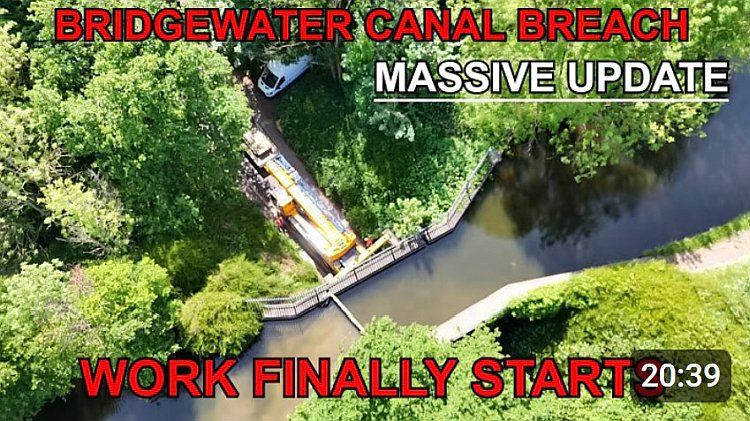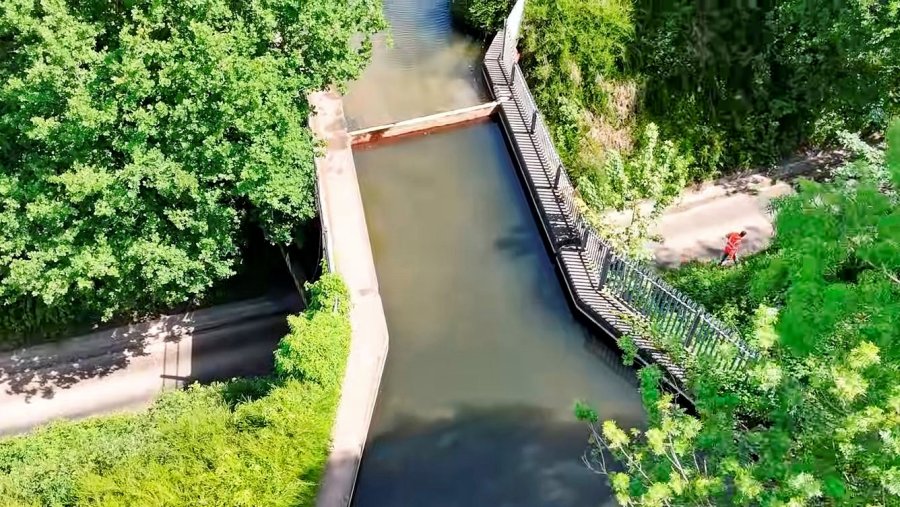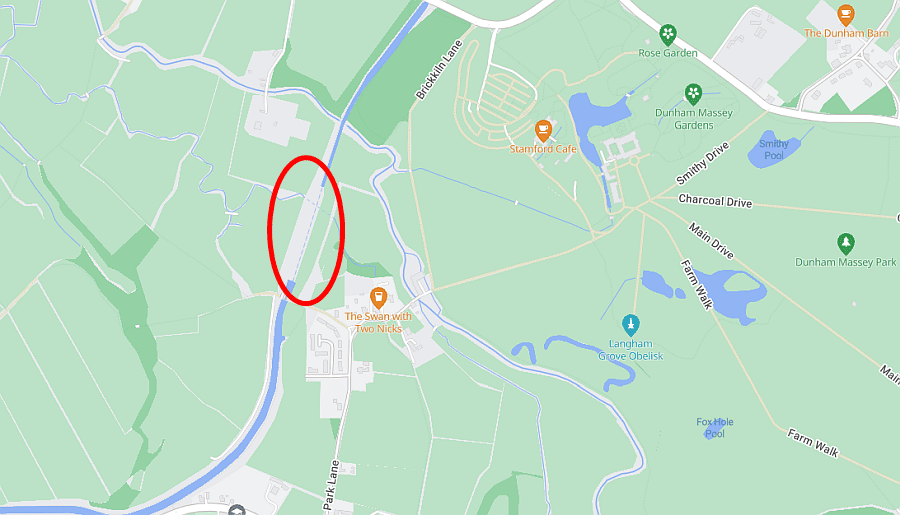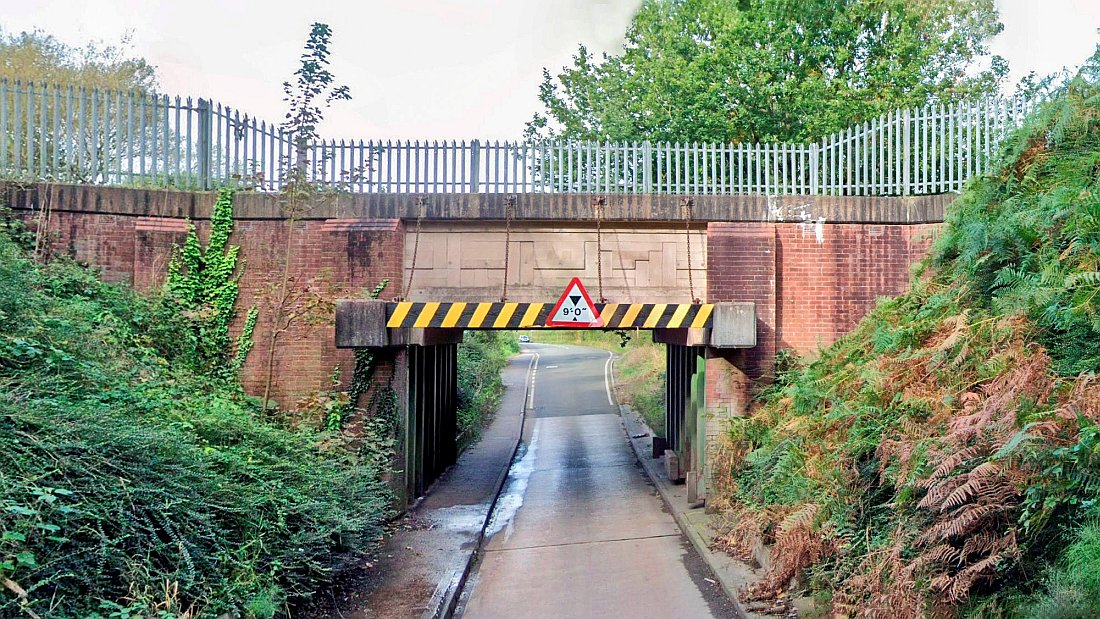Here’s the latest on the Bridgewater canal’s woes as work to repair/rebuild the disastrous breach at Dunham Massey gets underway! Having now done this fifth instalment on the Bridgewater – it somehow feels like I’m Ryan the Ride Mechanic! Instead of discussing the engineering problems of theme park rides (of which a few have been featured on London Rail) its all about the engineering problems of the canals! Unlike Ryan I’m not even an engineer of any sort, but have some background acquired over the past fifty years including working with some of the country’s prominent canal pioneers such as David Hutchings and Graham Palmer during the 1970s – as well as having also personally organised dedicated canal work parties in the Midlands and these undertaken in conjunction with British Waterways (and in some cases we also had help from British Waterways too!)
The above, combined with a number of canal breaches in the 1970s/1980s which I observed at close up the work to repair these stricken sections of canal, formulates my background knowledge. Again, I’m merely an amateur waterways person whose thoughts are a consist of those experiences that were gained four or five decades ago – but hopefully there is something of interest in regards to the Bridgewater breach.
Woodhouse Lane aqueduct from Google Streets showing where the stop planks would have gone. The stop plank groove on the towpath side can be accessed by way of removing the concrete slab slotted into the towpath.
The latest news is Peel (or rather the contractors they are employing) have installed stop planks at Woodhouse Lane aqueduct (or underbridge as it would be known on the Bridgewater). For this work to be done the road itself had to be closed to traffic. It was a large job because a substantial crane was necessary in order to lift these new stop planks up and over into the aqueduct itself.

Explore with Ant’s latest video on the Bridgewater breach which can be seen at Youtube.
The knowledge of this work comes from Explore with Ant who has done a good number of Youtube updates on progress at the breach. His latest video shows workers installing the stop planks and in fact there’s two guys wearing wetsuits who have gone into the canal itself in order to ensure these stop planks fit tightly and the seals have been furnished properly – with the help of plastic or rubber sheeting.
The road based crane used for this work can also be seen on his video as well as the workers who are located about the site doing their respective tasks. The crane was from Ainscough who have various bases dotted around the UK.

The new stop planks in place at Woodhouse Lane. The large Ainscough crane had by this time left and one worker (seen in orange jacket at right) is checking over the site to ensure everything is fine. Explore with Ant/Youtube.
It was assumed this meant work was about to begin at the breach site. That is possible, however I think the first immediate concern for putting these new stop planks in has to be the fact the breached section of canal keeps shifting somewhat and bits of it continue to break away – especially with this prolonged dry weather the UK is having. Thus the temporary cofferdams – which are sited on the affected section of the embankment – are not to be fully trusted although they are doing a great job. Hence a proper cut-off at the Woodhouse Lane aqueduct is perhaps the first step towards ensuring the entire section of embankment between Woodhouse Lane and Bollington (Park Lane) Aqueducts is completely isolated.
The other thing that is possible (as I have noticed one or two have made that thought in the comments too) is this is a precursor to getting machinery up there to begin work. In a previous video Explore with Ant had made – some workers were seen analysing the ground conditions near the site of the breach, and what I think might have happened there is these workers had found the ground was not suitable for any sort of temporary roadway to the work site. So its possible any initial work might be done via the canal itself – that is after draining it first! Its just an assumption that this is what happened – and I could be wrong.
The canal at Bollington underbridge (aka Park Lane aqueduct). From here to Woodhouse Lane there’s no doubt most of that embankment (around 525 metres or 1722 feet – half a kilometre or a third of a mile) is going to have to be rebuilt.
If its to do with the ground conditions as has been assumed, it quite possibly means access to the whole site initially will be made from the main road. A temporary road up from Woodhouse Lane onto the embankment and canal bed and then along the canal’s alignment towards the breached area where all the collapsed steel piling and all of the sandy sections of the embankment will need to be removed – because none of it is going to be of any use in a million years (as I highlighted in my Bridgewater report #3 which clearly reveals the fact this particular embankment was originally built with sand!!)
I would think then they would progress in the eastward direction towards Woodhouse Lane and remove most of the remaining embankment which was not encased as part of the 1970s work (the concreted and piled section of embankment forms about a quarter of the total length between Woodhouse Lane aqueduct and the breach site – and this was the section that was rebuilt in the 1970s following the breach of 1971 (there’s a couple of pictures of this in my Bridgewater report #1).
Google Streets view of the section of canal built between 1972 and 1973 following the canal’s 1971 breach.
Certainly what happens after is subject to further debate – but its possible that having done all this preliminary work (removal of the embankments and piling and any damaged structures etc), the next step would then be the major work of remodelling, preparation of the worksites and ensuring the ground conditions was optimal (by way of levelling it and adding new aggregate material and pressing that down to make a solid base), maybe even making a concrete base and sides and the rest of it.
Then it would be possible to also build a new service road to the site and that is when the main body of work to rebuild the canal would begin. Very likely there would be a concrete wall or ‘steps’ or maybe concrete blocks (this to prevent any future movement) and these would be placed at the lower levels. A new upper channel encased totally in concrete would then be built (I indicated this in my earlier posts) and then the sides filled with earth to render it as an embankment in order to ensure it fitted properly into the surrounding landscape – especially as the canal is a historic site (with Dunham Massey house almost adjacent) plus the stone arched Bolin aqueduct within the affected section is a Grade II listed structure.
I had suggested a modern aqueduct be built between Bollington (Park Lane) and the Bolin Aqueduct. That would have been the easiest way of going about it, but it seems its going to have to be done in a way that would match the canal’s previous appearance. In any event an aqueduct could still be built and an embankment formed around it rather. My initial thinking behind that had been the fact the entire embankment would have to be removed and rebuilt and then it would take time for it to settle before actually building a proper channel along the top. I did however assert the sooner this job was begun, then a proper canal embankment could be built given the timescale Peel are envisaging – including a completion date of December 2026.

A search for road closures was conducted on the Cheshire East website – however nothing was indicated right up to 2028. It seems that possibly nothing further will happen until perhaps later this summer when some other road closure requests might be put in. Curiously the Cheshire roads map clearly shows the Bridgwater canal is non extant at the site of the breach itself. It must be the only map on the internet that currently shows this missing canal section. How about that!
UPDATE 19TH MAY 2025
Explore with Ant has just issued a new video today – and says the embankment continues to collapse – a substantial section has done so recently. The fact it continues to collapse has been observed by many over the past couple of months however this newest shift has added more slippage to the total.
As I have said, the whole embankment is built from sand (as evidenced from a report on the construction of this section of canal) and with this very dry weather continuing, its just going to crumble away. Its a sobering fact. The fact these new stop planks were put in at Woodhouse Lane illustrates that the existing embankment (or what remains of it) cannot even be trusted to stay up – except perhaps the 250metre section rebuilt in the 1970s).
Even that 1970s section could go if the weight of the failed piling pulls on that – this has already happened over about 35 metres (and this latest slip adds a couple more metres). Thus it makes sense to have the canal cut off (dammed) at Woodhouse Lane. As has been said, approximately 525 metres of embankment (including the 218 metre section immediately west of Woodhouse Lane) will also need to be rebuilt. This will entail work over approximately a 745 metre length of canal. So far its roughly 525 metres that’s looking to be rebuilt (218 metres plus 307 metres with the 1970s built 250 metre section plus the Bolin aqueduct in between) but the more the main affected section slips the bigger the task will be.
Its a shame about the fish caught in that now isolated watered section. Hopefully the EA (or one of their appointed contractors) will be able to rescue these fish before this section of canal gets drained. If that does happen it will likely be a simple transfer into the section leading to School Lane bridge – unless there is an opportunity to relocate the fish elsewhere where far more swim will be available.
The featured image is the Woodhouse Lane aqueduct created from a merge of two different Google views.

Leave a Reply